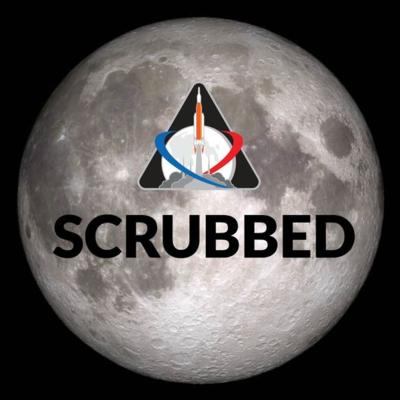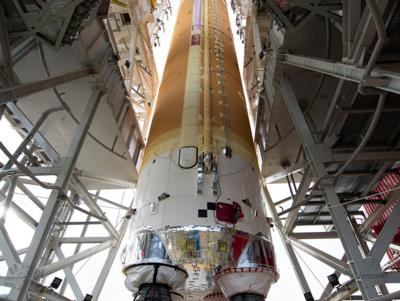Sun, Sep 04, 2022
NASA to 'Stand Down' on Artemis I Launch Attempts in Early September
After standing down on today’s Artemis I launch attempt when engineers could not overcome a hydrogen leak in a quick disconnect, an interface between the liquid hydrogen fuel feed line and the Space Launch System (SLS) rocket, mission managers met and decided they will forego additional launch attempts in early September.

Over the next several days, teams will establish access to the area of the leak at Launch Pad 39B, and in parallel conduct a schedule assessment to provide additional data that will inform a decision on whether to perform work to replace a seal either at the pad, where it can be tested under cryogenic conditions, or inside the Vehicle Assembly Building.
To meet the requirement by the Eastern Range for the certification on the flight termination system, currently set at 25 days, NASA will need to roll the rocket and spacecraft back to the VAB before the next launch attempt to reset the system’s batteries. The flight termination system is required on all rockets to protect public safety.
During today’s launch attempt, engineers saw a leak in a cavity between the ground side and rocket side plates surrounding an 8-inch line used to fill and drain liquid hydrogen from the SLS rocket. Three attempts at reseating the seal were unsuccessful. While in an early phase of hydrogen loading operations called chilldown, when launch controllers cool down the lines and propulsion system prior to flowing super cold liquid hydrogen into the rocket’s tank at minus 423 degrees F, an inadvertent command was sent that temporarily raised the pressure in the system. While the rocket remained safe and it is too early to tell whether the bump in pressurization contributed to the cause of the leaky seal, engineers are examining the issue.

Because of the complex orbital mechanics involved in launching to the Moon, NASA would have had to launch Artemis I by Tuesday, Sept. 6 as part of the current launch period. The launch day must account for the Moon's position in its lunar cycle so that the SLS rocket’s upper stage can time the trans-lunar injection burn with enough performance to successfully intercept the "on ramp" for the lunar distant retrograde orbit. The more powerful Exploration Upper Stage on future configurations of the rocket will enable daily, or near-daily, launch opportunities to the Moon, depending on the orbit desired.
Additional Artemis Launch Windows:
September 19 – October 4
- 14 launch opportunities
- No launch availability on Sept. 29 and Sept. 30
October 17 – October 31
- 11 launch opportunities
- No launch availability on October 24, 25, 26, and 28
November 12 – November 27 (preliminary)
- 12 launch opportunities
- No launch availability on November 20, 21, and 26
December 9 – December 23 (preliminary)
- 11 launch opportunities
- No launch availability on December 10, 14, 18, and 23
More News
Ultrahigh Frequency (UHF) The frequency band between 300 and 3,000 MHz. The bank of radio frequencies used for military air/ground voice communications. In some instances this may >[...]
During The 7 Second Descent, There Was Another TAWS Alert At Which Time The Engine Remained At Full Power On October 24, 2025 at 2115 mountain daylight time, a Cirrus SR22T, N740TS>[...]
From 2009 (YouTube Edition): Educational Organization Aims to Inspire by Sharing Tuskegee Story Founding leader Don Hinz summarized the Red Tail Project’s mission in simple, >[...]
“This feels like an important step since space travel for people with disabilities is still in its very early days... I’m so thankful and hope it inspires a change in m>[...]
Also: New Katanas, Kern County FD Training, IndiGo’s Botched Roster, MGen. Leavitt Named ERAU Dean The Australian Transportation Safety Bureau (ATSB) has wrapped up its inves>[...]
 ANN's Daily Aero-Term (12.19.25): Ultrahigh Frequency (UHF)
ANN's Daily Aero-Term (12.19.25): Ultrahigh Frequency (UHF) NTSB Prelim: Cirrus Design Corp SR22T
NTSB Prelim: Cirrus Design Corp SR22T Classic Aero-TV: The Red Tail Project--Carrying the Torch of the Tuskegee Airmen
Classic Aero-TV: The Red Tail Project--Carrying the Torch of the Tuskegee Airmen Aero-News: Quote of the Day (12.19.25)
Aero-News: Quote of the Day (12.19.25) Airborne 12.17.25: Skydiver Hooks Tail, Cooper Rotax Mount, NTSB v NDAA
Airborne 12.17.25: Skydiver Hooks Tail, Cooper Rotax Mount, NTSB v NDAA




